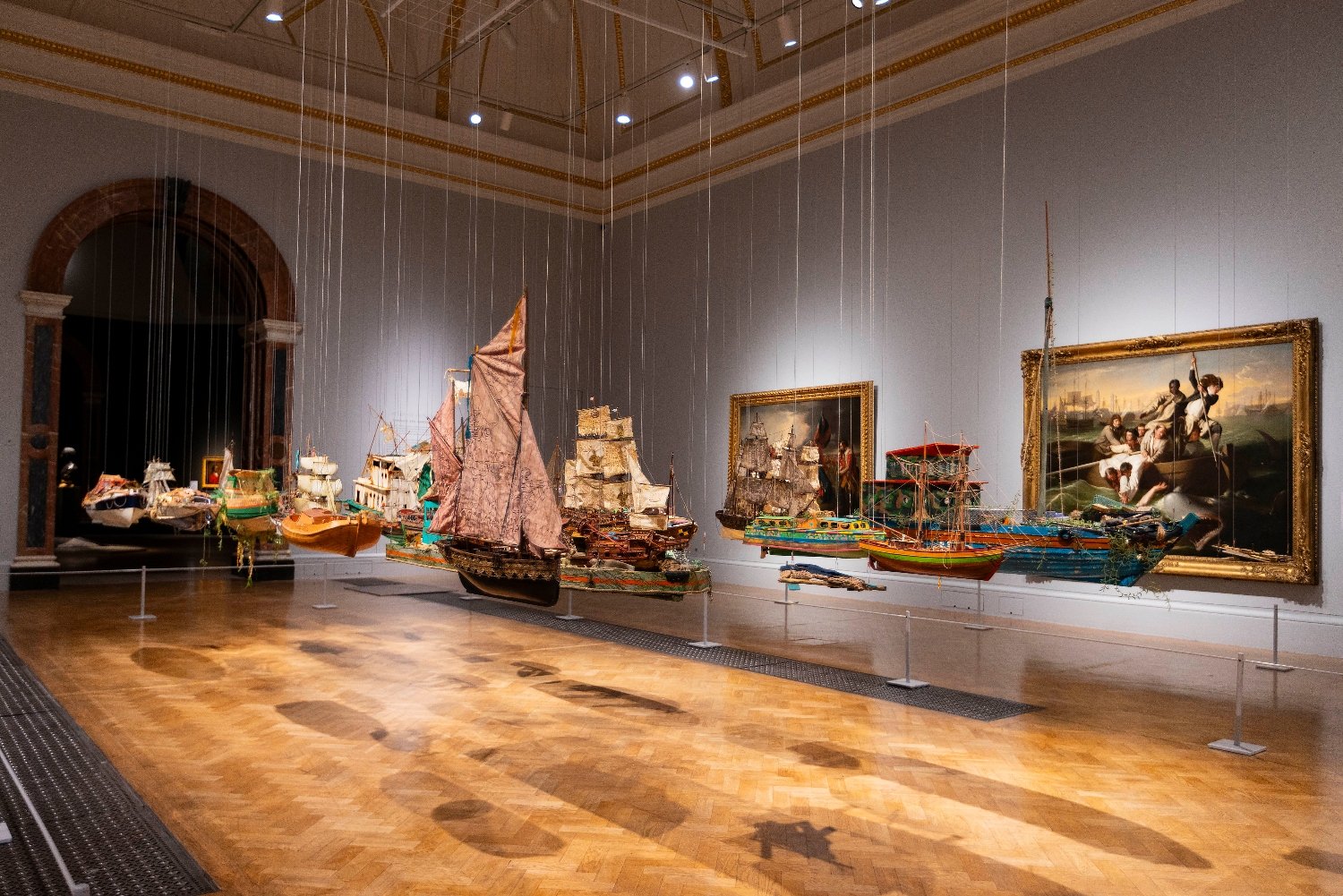
We are fortunate enough to live in a time when many contemporary artists are reckoning with the past and making heard the once suppressed voices of people of color, women, and members of the LGBT+ community. Often, however, representations of the white- and male-focused histories being redressed are physically absent from exhibitions of such works.
Not so at the Royal Academy’s “Entangled Pasts: Art, Colonialism, and Change” in London. Here, historical documents of empire, systemic exclusion, and outright racism are shown side-by-side with monumental works by some of the U.K.’s leading contemporary artists like Frank Bowling, Yinka Shonibare, Isaac Julien, Sonia Boyce, and Lubaina Himid. Other major headliners include El Anatsui, Kerry James Marshall, Kara Walker, Betye Saar, and of course, Tavares Strachan’s majestic public sculpture in the museum’s courtyard.
John Singleton Copley, Watson and the Shark (1778). Photo: © 2024 Museum of Fine Arts, Boston.
The role of art in shaping convenient narratives and promoting those with power is exemplified by many of the historical paintings on show. The American artist John Singleton Copley was an Academician known to have owned enslaved people and among his works in the show is a double portrait of a plantation owner’s daughters Mary and Elizabeth Royall (ca. 1758). His painting Watson and the Shark (1778) thrilled audiences when it was first shown at the RA for its depiction of a shark attack in Havana harbor, imbuing Britain’s activities across the Atlantic with a sense of heroic excitement.
These canvases form the backdrop to the exhibition’s standout work, Hew Locke’s Armada (2017–19), a suspended fleet of ships. These intricately detailed, colorful vessels represent various moments in history, from the Mayflower that brought early colonizers to America in the 1600s to the cruise liner HMT Empire Windrush, which carried Caribbean passengers to a new life in the U.K. in 1948. Local economies are represented by shipping boats while cargo ships are synonymous with modern-day global trade networks.
Kerry James Marshall, Scipio Moorhead, Portrait of Himself, 1776 (2007). Photo: James Prinz Photography, courtesy of the artist and Jack Shainman Gallery.
Landscapes by the 18th century English painter William Hodges are typical for their era in how they depict places like the Caribbean and India as exotic, untouched idylls that bear no trace of colonial violence. They are placed beside Yinka Shonibare’s Woman Moving Up (2023), which directly quotes the grand staircase at Chatsworth House as a symbol for the generational wealth evident in Britain’s many country houses, much of which was accumulated by investment in colonial ventures abroad. A female figure ascends the staircase, representing for Shonibare the migration of Black Americans away from Southern states during the 20th century.
“While the geographical move for African Americans ended in 1970,” the artist explained in the show’s catalog, “the spiritual, cultural, economic, and social uprising has yet to cease.”
Installation view of the “Entangled Pasts, 1768–now. Art, Colonialism and Change” at the Royal Academy of Arts, London, featuring Yinka Shonibare’s Woman Moving Up (2023), courtesy the artist and James Cohan Gallery, New York. Photo: © Royal Academy of Arts, London / David Parry. © Yinka Shonibare CBE RA.
The RA itself is implicated as a force of oppression and exclusion within the exhibition, which at least attempts to reckon with its own history as a venue for the promotion of Britain’s imperial ideals throughout the 18th and 19th centuries. The considerable crowds that flocked to its salons to witness works like those by Hodges and Copley are evidenced by a cartoon form 1787.
It would be a mistake to think that the promulgation of detrimental colonial values was limited to before the 20th century. Painter Frank Dicksee, who was president of the RA from 1924 to 1928, insisted that “our ideal of beauty must be the white man’s,” a world view clearly at play in his work Startled (1892), in which two pale figures frolic under a purifying golden light. Another damning painting in the exhibition is The Royal Academy Selection and Hanging Committee 1938 (1939) by Frederick William Elwell, which shows a formal dining table around which pompous white men sit and confer.
Installation view of the “Entangled Pasts, 1768–now. Art, Colonialism and Change” at the Royal Academy of Arts, London, featuring El Anatsui’s Akua’s Surviving Children (1996), courtesy of the artist and October Gallery, and Frank Bowling, Middle Passage (1970), © Frank Bowling. All Rights Reserved, DACS 2024. Photo: © Royal Academy of Arts, London / David Parry.
Most staggering of all, however, is the fact that the first Black member to be elected to the Royal Academy was Frank Bowling in 2005.
In this exhibition, his majestic canvas Middle Passage (1970) is an abstracted meditation on the horrors of the transatlantic slave trade. Yellows, oranges, and greens refer to his birthplace of Guyana and we can make out the faint but familiar outlines of Africa and the Americas. It is staged in conversation with El Anatsui’s Akua’s Surviving Children (1996), in which pieces of driftwood are assembled to imply a gathering of figures. The sculpture was made while the artist was in Copenhagen for a conference on the Danish slave trade, during which he discovered pieces of wood washed up on a beach that brought to mind the many people who had been torn from their homeland and enslaved.
“Entangled Pasts: Art, Colonialism and Change” is on view at the Royal Academy in London through April 28, 2024.